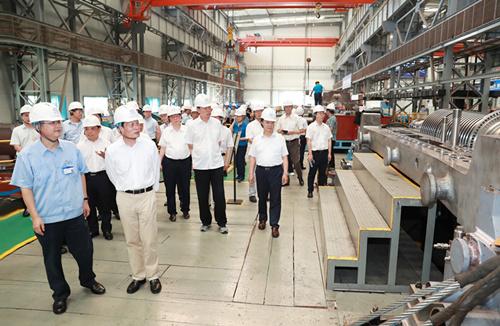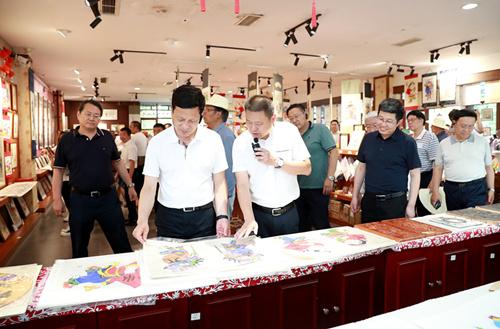CASS Member research team surveys Sichuan
Author:GAO YING Source: Chinese Social Sciences Today 2021-08-05
Led by CASS President Xie Fuzhan, the research team visits the Chengdu Tianfu New Area. Photo: Zhu Gaolei/CSST

The team visits Dongfang Turbine Co., Ltd.. Photo: Zhu Gaolei/CSST

The team visits a village specializing in producing New Year paintings in Mianzhu City. Photo: Zhu Gaolei/CSST
From July 19 to 23, a research team led by Xie Fuzhan, president of the Chinese Academy of Social Sciences (CASS), secretary of the Leading Party Members’ Group at CASS, and chairman of the CASS Presidium, carried out an academic investigation in southwest China’s Sichuan Province. The team consisted of 18 CASS Members, including Gao Peiyong, CASS vice-president and member of the Leading Party Members’ Group at CASS, as well as Cai Fang, Li Yang and Li Peilin, who are all former vice-presidents of CASS.
The survey lasted for five days, when the team visited three cities and 18 survey sites. The survey topics included the construction of the Chengdu-Chongqing dual city economic circle innovative regional layout, industrial transformation and upgrade, and cultural heritage development and protection.
Innovation is the primary force driving development and the strategic backing for the construction of a modern economic system. During the survey, the CASS Members went to Mianyang Science and Technology City (New Area), Sichuan Large Scientific Instrument Sharing Platform, Chengdu BOE Optoelectronics Technology Co., Ltd., Dongfang Turbine Co., Ltd. and so on to investigate enterprises’ innovation capacity, research and development input, and the construction of urban scientific and technological innovation platforms.
Moreover, they visited the Sanxingdui Ruin Site in Guanghan City, one of the most significant archaeological finds of the 20th century, to inform themselves of the latest progress in related archaeological work.
Many artifacts unearthed from the site provide material evidence for the research on the “diversity in unity” historical course of Chinese civilization. CASS Member Li Lin, also former director of the Institute of Law at CASS, called for equal attention to diversity and unity, urging multidisciplinary studies of unity. It is essential to examine the formation and development of the Chinese nation community from legal, political, and economic angles, thereby telling to the world vivid stories concerning Chinese civilization, Li said.
The survey was also a journey to learn more profoundly about the history of the Community Party of China (CPC). Time-honored Sichuan has not only fostered distinctive traditional cultures, but is also one of the areas where Marxism was initially disseminated in China.
Over the past century, the CPC led people in Sichuan to develop a rich historical heritage and spirit in the course of revolution, construction, and reform. The Long March spirit, the Two Bombs and One Satellite spirit, the spirit to combat the 2008 Wenchuan Earthquake, and the poverty alleviation spirit have greatly enriched the spiritual genealogy of CPC members. During the visits to the Two Bombs City, 5?12 Wenchuan Earthquake Memorial Museum, old and new Beichuan county town, and poverty alleviation demonstration areas, the CASS Members were touched by the valuable moral characters and high spirits of the Sichuan people many times.
At the village specializing in producing New Year paintings, a national-level intangible cultural heritage item, in Mianzhu City, the research team walked into New Year painting enterprises and workshops to survey how distinctive cultures lead industrial vitalization in rural areas. The annual sales volume of New Year paintings has exceeded 40 million yuan in the village.
Into the new era, Sichuan has embraced new development opportunities. It has been involved deeply in such national strategies as the construction of the Yangtze River Economic Belt, the Chengdu-Chongqing Economic Circle, ecological conservation and high-quality development of the Yellow River Basin, as well as major engineering projects like the Sichuan-Tibet Railway and the New Western Land-Sea Corridor. The province’s strategic position is increasingly prominent.
The economic and social development of a big province has a big bearing on the whole nation, noted CASS President Xie Fuzhan at a discussion between the CASS delegation and representatives of Sichuan Province. “As a populous province with outstanding economic strength, Sichuan has implemented new development philosophies completely, accurately, and comprehensively in its development course for the sake of high-quality growth,” Xie said.
Based on the survey, Xie and other CASS Members offered suggestions for the governance and thriving of Sichuan in the new era from the perspective of their respective research fields. Their targeted proposals were hailed by attending Sichuan leaders, who expressed their expectations of deeper cooperation with CASS and welcome for more suggestions from the Chinese premier think tank.

